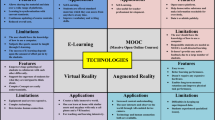Abstract
This paper introduces an augmented reality-based framework (called AugmentedBook) for e-learning that allows the creation of collaborative notes, illustrative media (i.e. video, 2D or 3D image, audio) for mobile devices or Google glass. The augmented content can be added to real-world educational support to make it more comprehensive, interactive and collaborative. In this platform, students and teachers can add collaborative notes to any part of the educational support system. They can also find illustrative media and indicate the pertinence of the result. Using our AugmentedBook platform, students can also download the enriched support using a mobile device. Our framework solves the problem of standard integration of augmented reality applications in education, offering a distributed framework which is e-learning compliant.
Access this chapter
Tax calculation will be finalised at checkout
Purchases are for personal use only
Similar content being viewed by others
Notes
References
Dalsgaard, C.: Social software: E-learning beyond learning management systems. Eur. J. Open Dist E-Learn. (2006). http://www.eurodl.org/materials/contrib/2006/Christian_Dalsgaard.htm
Akçayır, M., Akçayır, G.: Advantages and challenges associated with augmented reality for education: a systematic review of the literature. Educ. Res. Rev. 20, 1–11 (2017)
Wu, H.-K., Lee, S.W.-Y., Chang, H.-Y., Liang, J.-C.: Current status, opportunities and challenges of augmented reality in education. Comput. Educ. 62, 41–49 (2013)
Di Serio, A., Ibáñez, M.B., Kloos, C.D.: Impact of an augmented reality system on students’ motivation for a visual art course. Comput. Educ. 68, 586–596 (2013)
Liarokapis, F., Mourkoussis, N., White, M., Darcy, J., Sifniotis, M., Petridis, P., Basu, A., Lister, P.F.: Web3d and augmented reality to support engineering education. World Trans. Eng. Technol. Educ. UICEE 3(1), 11–14 (2004)
Wang, M.-J., Tseng, C.-H., Shen, C.-Y.: An easy to use augmented reality authoring tool for use in examination purpose. In: Forbrig, P., Paternó, F., Mark Pejtersen, A. (eds.) HCIS 2010. IFIP AICT, vol. 332, pp. 285–288. Springer, Heidelberg (2010)
Orduña, J.M., Fernández, M., Gimeno, J., Morillo, P.: An advanced authoring tool for augmented reality applications in industry. In: XXIII Jornadas de Paralelismo, pp. 586–591 (2010)
Kose, U., Koc, D., Yucesoy, S.A.: An augmented reality based mobile software to support learning experiences in computer science courses. VARE Proc. Comput. Sci. 25, 370–374 (2013)
Henrysson, A., Billinghurst, M., Ollila, M.: Face to face collaborative AR on mobile phones. In: ISMAR 2005 Proceedings of the 4th IEEE/ACM International Symposium on Mixed and Augmented Reality, pp. 80–89, IEEE, Washington (2005)
Furio, D., GonzáLez-Gancedo, S., Juan, M.-C., Seguí, I., Costa, M.: The effects of the size and weight of a mobile device on an educational game. Comput. Educ. 64, 24–41 (2013)
Chiang, T.H., Yang, S.J., Hwang, G.-J.: Students’ online interactive patterns in augmented reality-based inquiry activities. Comput. Educ. 78, 97–108 (2014)
Hwang, G.-J., Tsai, C.-C., Chu, H.-C., Kinshuk, K., Chen, C.-Y.: A context-aware ubiquitous learning approach to conducting scientific inquiry activities. Aust. J. Educ. Technol. 28(5), 931–947 (2012)
Chiang, T.H., Yang, S.J., Hwang, G.-J.: An augmented reality-based mobile learning system to improve students’ learning achievements and motivations in natural science inquiry activities. J. Educ. Technol. Soc. 17(4), 352–365 (2014)
Bressler, D., Bodzin, A.: A mixed methods assessment of students’ flow experiences during a mobile augmented reality science game. J. Comput. Assist. Learn. 29(6), 505–517 (2013)
Johnson, L., Laurence, F., Smith, R., Stone, S.: The 2010 horizon report. The New Media Consortium, Austin, Texas (2010)
Chin, J.P., Diehl, V.A., Norman, K.L.: Development of an instrument measuring user satisfaction of the human-computerinterface. In: Proceedings of the SIGCHI Conference on Human Factors in Computing Systems, CHI 1988, pp. 213–218. ACM, New York (1988)
Lewis, J.R.: IBM computer usability satisfaction questionnaires: psychometric evaluation and instructions for use. Int. J. Hum.-Comput. Interact. 7(1), 57–78 (1995)
Brooke, J.: SUS-a quick and dirty usability scale. Usability Eval. Ind. 189(194), 4–7 (1996)
Brooke, J.: SUS: a retrospective. J. Usability Stud. 8(2), 29–40 (2013)
Author information
Authors and Affiliations
Corresponding authors
Editor information
Editors and Affiliations
Rights and permissions
Copyright information
© 2020 Springer Nature Switzerland AG
About this paper
Cite this paper
Alzahrani, N.M., Lajmi, S. (2020). AugmentedBook: A Collaborative E-Learning Augmented Reality Platform. In: Ahram, T., Taiar, R., Colson, S., Choplin, A. (eds) Human Interaction and Emerging Technologies. IHIET 2019. Advances in Intelligent Systems and Computing, vol 1018. Springer, Cham. https://doi.org/10.1007/978-3-030-25629-6_44
Download citation
DOI: https://doi.org/10.1007/978-3-030-25629-6_44
Published:
Publisher Name: Springer, Cham
Print ISBN: 978-3-030-25628-9
Online ISBN: 978-3-030-25629-6
eBook Packages: EngineeringEngineering (R0)




